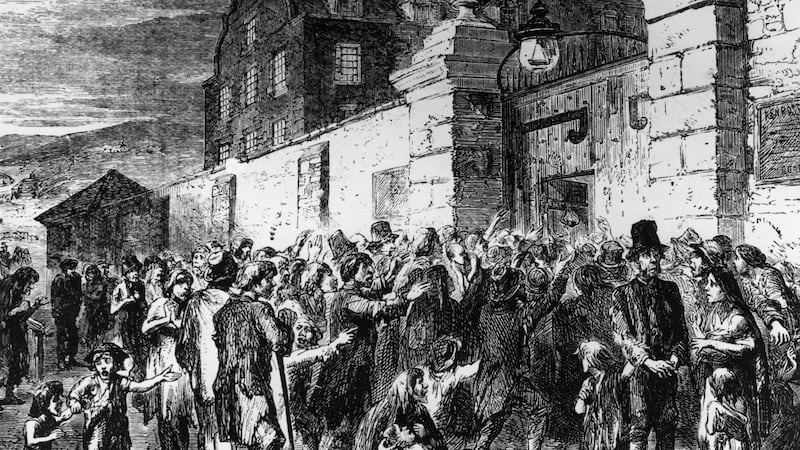As our cargo ship of the Ellerman Line moved along the Gulf of St Lawrence seaway towards the port city of Quebec, I went to the wing of the bridge to take a look at Grosse Île – a long island in the middle of the wide river.
The chief officer, a Scotsman who had been sailing in these parts for several years, told me that it had once housed a quarantine station for immigrants, many of them from Ireland.
I found out later that in the year 1847 it was the site of appalling scenes where thousands of Irish, many stricken with typhus fever, had died.
The small quarantine facility had been set up on Grosse Île in 1832 to handle a relatively manageable inflow of immigrants from Europe, many from Ireland. However, 15 years later it was overwhelmed by the tens of thousands of Irish emigrants fleeing the Great Famine.
The quarantine facilities were pitifully inadequate to handle the thousands of sick who needed attention
They arrived in shamefully overcrowded vessels where the atrocious sanitary conditions had contributed to the outbreak and rapid spread of typhus fever. Many had already succumbed to the disease during the voyage across the North Atlantic, their bodies put over the side. Some ships still had corpses on board when they arrived.
The authorities in Montreal and Quebec were alarmed by the masses of malnourished, disease-ridden immigrants trying to gain entry to the country. All immigrant ships were required to report to Grosse Île and their passengers cleared through the quarantine station there before being allowed to go on to the Canadian mainland.
During May 1847, some 40 ships, carrying 12,500 feeble, ill and dying immigrants arrived. They were obliged to anchor in the river without medical attention or nourishment while the ill-equipped doctors, nurses and carers did their best to work through the restricted numbers allowed to land. Inevitably there were many deaths on board and many more among those who were later hospitalised when they were eventually allowed to go ashore to the quarantine station.
The quarantine facilities were pitifully inadequate to handle the thousands of sick who needed attention. The small hospitals lacked proper space. There were sheds originally intended to house patients. These were without ventilation or sanitation and were now crammed with sick and supposedly healthy men women and children. Some had to lie on the open ground.

As they died, they infected some of the doctors, nurses, orderlies and policemen trying to look after them. Clergymen, Protestant and Catholic, tried to offer some comfort to the stricken; some of these became infected themselves and died.
So swamped were the doctors that any passenger who seemed in reasonable condition was passed as healthy. As a result, many of the discharged carried the disease into Quebec and Montreal.
It is estimated that between 1845 and 1849, some 3,000 Irish died on the island and that 5,000 people are buried in the cemetery there. It is also reckoned that 5,000 people on ships bound for Canada had been buried at sea.
There were also established communities of Irish in these cities who gave support and succour to the destitute arrivals
Gradually the quarantine facilities on the island improved while the inflow of stricken Irish immigrants decreased. The station eventually closed in 1932.
In 1909, a Celtic cross memorial was erected at a high point on the island by the Ancient Order of Hibernians with inscriptions in Irish, French and English. In 1974 the Canadian government declared Grosse Île a national historic site. Some 20 years later a campaign by descendants of the victims had the island dedicated as a Famine memorial, with protection for the mass graves.
Today visitors can see two buildings that have been preserved. One is a fever shed and the other the lazaretto (quarantine disinfectant station). This building features an exhibition of the tragic events that are now part of the Irish emigration history in Canada. There is a walking trail to the Celtic cross.
By all accounts the people in Quebec, French-speaking and English-speaking alike, were helpful and sympathetic to the destitute Irish, despite fears of infection and the civic burden of looking after the large numbers.
There were also established communities of Irish in these cities who gave support and succour to the destitute arrivals.
The island's Irish Memorial Site was twinned with the National Famine Museum in Strokestown, Co Roscommon, in 1998. Presidents Mary Robinson and Mary McAleese visited Grosse Île on their official visits to Canada in the 1990s. They both placed a wreath at the Celtic cross. Both emphasised that the Irish experience of famine had gone deep into the national psyche and created a deep awareness and empathy for those suffering from starvation, especially in parts of Africa.









